| Author | Message | ||
Brian Vogel Grand Master Username: guyslp Post Number: 2404 Registered: 6-2009 |
Gentlemen, I now appear to have the luxury of some time to get back in the garage and back to work on LRK37110. My next step, based on the advice received here, will be to remove the spark plugs so that I can easily turn the engine to TDC on A1 by hand and get the rotor arm definitively pointed to the A1 location on the cap at that point. However, this is giving me an opportunity to ask about a couple of other things as well. Just before LRK37110 went into hibernation in 2014 I had new catalytic converters put on her (the others had collapsed internally) and at the time the mechanic I used said that the plugs had fouled. I had installed NGK BPR4EYs and he replaced them with Champion 104 RN4Cs. At that time I got the NGKs back, and 7 of the 8 (I have no idea at the moment what I might have done with #8) are pictured below: 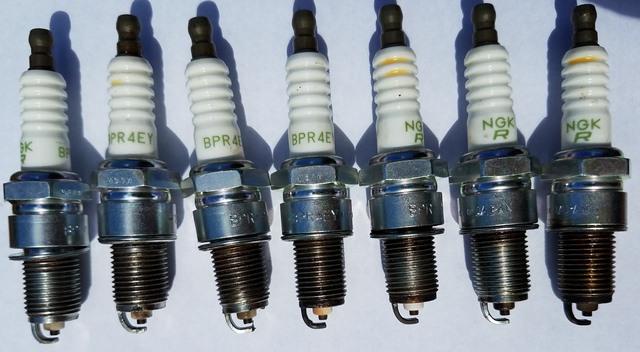  I do not know which cylinders each of these came from at this point, but I'm hoping that I will get a strong hint based on what I find when I pull the Champions, which have very little mileage on them just as these do. They don't look all that fouled to me except for the rightmost one. The car was not run even 100 miles on these plugs. But what's also interesting is that you can see that that rightmost one and two of the others have sooty grounds at the end while the other four do not. This leads me to suspect that I am probably going to find the cylinders fed by one of the two carbs overly rich. (I have to go back to look at which carb feeds which cylinders - for some reason I seem to recall it isn't right side A bank, left side B bank, but I could be mistaken). It also leads me to suspect that if I unearth #8 that it will be sooty. I'm just curious what those of you who have far more experience with this particular area have to say about my conjecture and/or to have you correct it (more critical, of course). I'll post photos of the Champions once I've pulled them for comparison. Brian | ||
Mark Aldridge Grand Master Username: mark_aldridge Post Number: 455 Registered: 10-2008 |
Brian, I would guess the second from the right is contributing nothing, but the far right is probably OK ish.. I would suspect a HT lead problem , or possibly a distributor cap issue on the second from right plug. Had a lead break up from its ferrule in the dizzy cap, and this caused similar plug fouling and weak/ missing on one cylinder. Mark | ||
Geoff Wootton Grand Master Username: dounraey Post Number: 1772 Registered: 5-2012 |
Hi Brian Numbering the plugs 1 - 7 where 1 is the leftmost plug, 1,2,3 and 6 look to me if they are supplied by one carb and the others by the other carb, which is running rich. It will be interesting to see a pic of the Champions when you have pulled (and labelled) them. If you remember the pop group ABBA, then you will know which carb services which cylinder. The other grouping is BAAB. Trouble is, I can't remember which carb is which. I'll look it up. Geoff | ||
Geoff Wootton Grand Master Username: dounraey Post Number: 1774 Registered: 5-2012 |
From Bob Reynolds in a previous thread - Each carb feeds the outer cylinders on its own bank, and the inner cylinders of the opposite bank. Geoff I wonder if Bob has sold his Rolls - haven't seen him on here for a long time. | ||
Brian Vogel Grand Master Username: guyslp Post Number: 2405 Registered: 6-2009 |
Geoff & Mark, Thanks to the both of you. I did a quick pull of plugs A4 and A3: 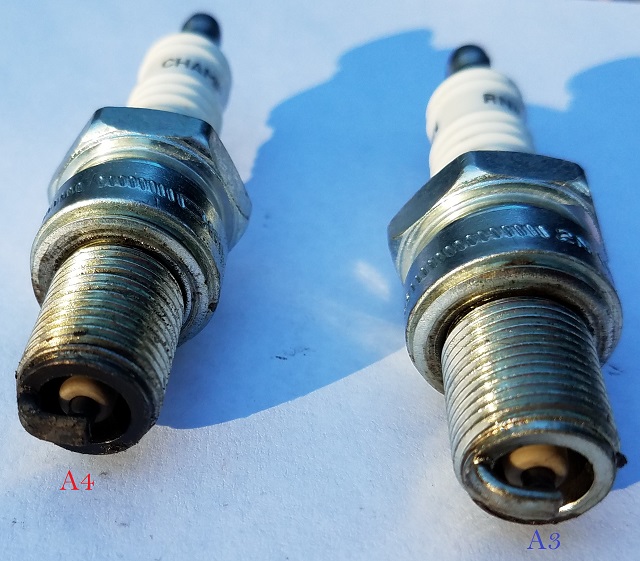 Based on the inner/outer arrangement described, I expect to find the following three plugs sooty and wet-ish: A1, B2, & B3 The clean looking ones will likely be: A2, B1, & B4. Brian | ||
David Gore Moderator Username: david_gore Post Number: 2656 Registered: 4-2003 |
Geoff, Bob Reynold's last post was mid-January this year - has he been active on other R-R/B Forums since? Brian, If your suppositions are correct, this would confirm you have a rich mixture problem. If not, you may have incontinent valve guides which has been the subject of past discussion on the forum - I think Richard Treacy contributed on upgrading the valve stem seals if my memory is reliable. | ||
Brian Vogel Grand Master Username: guyslp Post Number: 2406 Registered: 6-2009 |
David, Thanks. I would hope that with only 26K miles on the car that "incontinent valve guides" would not be at play, yet, anyway. But who knows. Luckily I have Mr. Opfar's splediferous dual dial setup for checking and balancing my carbs. Now I just have to read up on the actual steps this involves. Brian | ||
David Gore Moderator Username: david_gore Post Number: 2657 Registered: 4-2003 |
Looks like my memory is still functioning: http://au.rrforums.net/forum/messages/17001/1271.html?1102265833 http://au.rrforums.net/forum/messages/17001/22097.html?1477848831 The following thread has a useful hint from Bill Coburn on keeping the valves closed when removing/replacing the stem seals: http://au.rrforums.net/forum/messages/16999/3714.html?1133818361 . | ||
Kelly Opfar Prolific User Username: kelly_opfar Post Number: 177 Registered: 7-2004 |
I provide this YouTube link to everyone I send a sync kit to, that explains the dual indicator synchronization process: https://www.youtube.com/watch?v=3ih5h1J-AN4 BritishToolWorks.com | ||
Brian Vogel Grand Master Username: guyslp Post Number: 2407 Registered: 6-2009 |
Kelly, Ralph's videos are always quite useful. Now I just have to check out the differences between the HIF7s in my cars and the earlier carbs. One thing I know is that the piston dampers have a clip that holds them in at the top of the carb since one of those was (and still is) "hanging loose" at the top of one of SRH33576's carbs while the other is still firmly in place. Both are in place on LRK37110. You can't just withdraw them as is shown in Ralph's video of the older carbs, but otherwise they look exactly the same. LRK37110 was maintained by a Rolls-Royce dealer for her entire life until her owner became ill. I think that after she went into the garage for her 5-year plus nap that several "family members" tinkered with her (not too much, thank heaven!) and it wouldn't surprise me if someone might have messed with the mixture screws. That video is really great for demystifying a great many aspects of the SU carb. Brian | ||
Jim Walters Prolific User Username: jim_walters Post Number: 120 Registered: 1-2014 |
Brian, it looks to me like your A4 plug is oil fouled as indicated by wet chunky carbon bits. Overly rich mixtures will show up as a dry fluffy evenly deposited layer of carbon even on the porcelain insulation surrounding the centre electrode. In my extensive experience Champions are a poor choice of plug. Stick with NGK or Bosch, and fit iridium ones for the best service and longevity. They are much, much better than a normal spark plug in engines where some oil consumption is occurring. SRH8505 SRC18015 SRE22493 NAC-05370 www.bristolmotors.com | ||
Patrick Lockyer. Grand Master Username: pat_lockyer Post Number: 1505 Registered: 9-2004 |
Brian, if the car has covered 26k and not 10026k then three things spring to mind looking at the plugs. One, to have cats fail at that mileage and I do not believe they did, more likely a plug or plugs misfiring through whatever cause causing emission to fail. Two, intermittent firing cylinder can cause unbalance will cause valve guide seals and piston rings to let oil through. Three, going by the NGK plugs IMO you do not have a mixture balance problem. IMO get the engine up and running first with the NGK plugs and proper engine plug firing and timing. | ||
Patrick Lockyer. Grand Master Username: pat_lockyer Post Number: 1506 Registered: 9-2004 |
Brian, as for the retainer clip loose, unless it is broke the locating tangs can be opened up and the clip restored to hold itself in the piston damper. The fitment of the damper retainer clips are a must with the ball bearing suction chamber type. The damper can be used with care to raise the piston to fill the recess with oil also used instead of the piston lifting pins if out of reach. | ||
Brian Vogel Grand Master Username: guyslp Post Number: 2436 Registered: 6-2009 |
Gentlemen, I got back to work on LRK37110 this afternoon and here's "the line up" after all the plugs have been pulled: 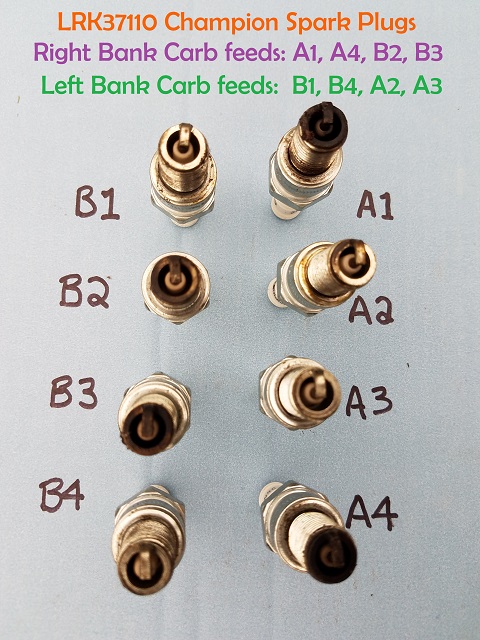 It's important to note that these Champion plugs have far fewer miles on them than the NGKs in the photos earlier in the thread did, and neither likely has even 100 miles on them in total. The car was only driven from where I had originally been working on it to my home and one other two service shops. It was the second service shop that replaced the plugs (which I am now questioning, but that's water under the bridge). Now, of course, I need to get things set up for starting her up with the new distributor. I seem to recall Mr. Gore saying I should turn the engine such that the TDC timing mark is directly under the pointer, so that will come next, but I am not at all certain about the technique to achieve this goal. Also, should I attempt to make any adjustment whatsoever to the A bank carb prior to trying to start the car again or should I leave everything as is and make those adjustments after I can get the car to fire up? Brian | ||
Geoff Wootton Grand Master Username: dounraey Post Number: 1816 Registered: 5-2012 |
Hi Brian I guess we will all have our different approaches but for me, I would definitely not touch the carbs at this stage. You know the engine will run with the current carb setup, so if you change it before sorting the ignition you will have introduced another variable, should you have difficulty in getting the engine to run. Once the engine is running and timed properly I would then focus on tuning the carbs. Turning the engine by hand is always difficult. I have read that if all the spark plugs have been removed it is possible to turn it via the drive belts. Apparently a socket on the compressor pulley will allow you to "pull" the crankshaft damper round. Geoff | ||
Paul Yorke Grand Master Username: paul_yorke Post Number: 1893 Registered: 6-2006 |
I'm with Geoff on the carbs and indeed how can you adjust them without the engine running. However never use the compressor pully nut to try and turn the engine. It adjusts the clutch clearance. With no plugs in it should be pretty free. Wedge a flat head screwdriver in the fan shaft nuts and pull. Crank the engine over on the starter a few times to get everything lubed and moving freely first. | ||
Paul Yorke Grand Master Username: paul_yorke Post Number: 1894 Registered: 6-2006 |
Ps. Ditch the champions. | ||
Brian Vogel Grand Master Username: guyslp Post Number: 2437 Registered: 6-2009 |
Thanks to all. I plan to ditch the Champions. As far as the screwdriver, are you saying to loosen the viscous fan clutch ever so slightly, wedge it in under there, tighten things down, use it as a lever to turn the engine, then reverse? I'm not quite certain how I'd wedge that screwdriver in there otherwise, but I haven't looked yet, either. I'll definitely give the engine a couple of turns on the starter before "going manual". This is going to be interesting, and I'll keep documenting what's happening as it goes along with as many photos as I can take. Someone's going to go down this road, or a similar one, at some point in the future. Brian | ||
ross kowalski Grand Master Username: cdfpw Post Number: 577 Registered: 11-2015 |
Brian, As for the plugs, b1,b4,a2,a3 are running lean. I'm actually surprised that you are not getting a lean miss on acceleration with that thin a mixture. If the engine runs and you have a colortune, turn the gas up on that carb until it goes orange, then back it off until it just goes blue. | ||
Geoff Wootton Grand Master Username: dounraey Post Number: 1817 Registered: 5-2012 |
Brian Here's a pic of how I interpret Paul's advice on rotating the engine. I read it as you do not have to loosen any nuts, you just push a large screwdriver between the nuts and the fan shaft. I've arrowed one of the gaps. I presume in practice you would go in from a more vertical position. 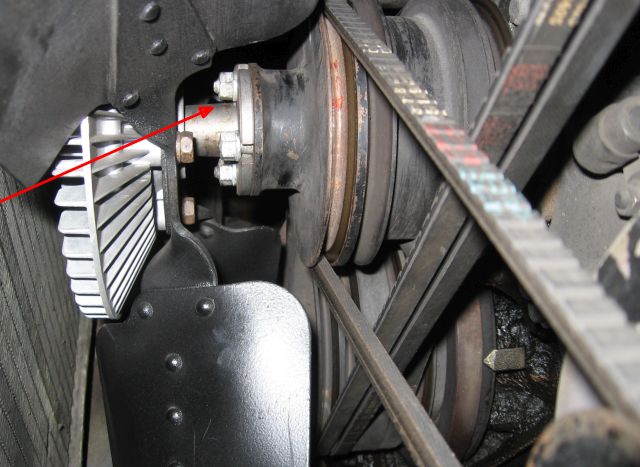 I'm sure Paul will correct me if I have got this wrong. I have read so many conflicting ways of how to rotate the engine. Paul has already outlined how NOT to do it i.e. don't use the compressor pulley. It would be good to have a definitive procedure. Geoff | ||
Paul Yorke Grand Master Username: paul_yorke Post Number: 1895 Registered: 6-2006 |
Geoff. . . You do well to decipher my sketchy ramblings. Correct. A long 1/2" ring spanner on the nut but wedged on the shaft so that it is the shaft not the nut that is taking the force also works well. | ||
ross kowalski Grand Master Username: cdfpw Post Number: 583 Registered: 11-2015 |
Brian, Remember that you can bump the car to nearly the correct position with the starter, so you really only have to turn the motor over a few degrees when setting TDC. | ||
Brian Vogel Grand Master Username: guyslp Post Number: 2439 Registered: 6-2009 |
Ross, That's what I was doing when the plugs were still in, but I could only get to "close, but no cigar". Now if I get that close I know that it's just a tiny bit of turn that I'll have to do. Based on my previous experience with SRH33576 and LRK37110 I believe there is only one TDC mark on the flywheel and once I've got the pointer pointing to it I then need to rotate the distributor such that the rotor arm is pointing to the A1 lead position on the cap (or perhaps a very tiny smidge past since I think I'm remembering that 5 degrees before TDC is the static timing). I am trying to keep my mind in the "this is all just a big puzzle to be solved" frame, as I can enjoy this sort of stuff when I do. I also know myself well enough to know when to walk away if/when I begin getting frustrated. I am not looking forward to getting the spark plugs back in on this car. With the EGR system (among other things) it's a lot more miserable to do this job than on SRH33576 which has a wide open engine bay by comparison. I seem to recall having done this the last time using a wooden dowel rod with a short piece of vinyl hosing on the end into which the spark plug was inserted. This made the job significantly more tolerable. Brian | ||
Patrick Lockyer. Grand Master Username: pat_lockyer Post Number: 1551 Registered: 9-2004 |
Talk about a mountain out of mole hill, time for the correct procedure here or is it the making of a really big puzzle just for the sake of it. Remember that TDC mark may not be the position for the rotor arm to A1 HT lead............. | ||
ross kowalski Grand Master Username: cdfpw Post Number: 588 Registered: 11-2015 |
Brian, Are you bumping the engine with the key? I did that puff test that I made the video of by shorting across the starter relay with my finger over the 1 plug hole. That way I was able to instantly stop cranking. There is one tdc mark on the crank pulley, but only every other time it lines up does it represent tdc on the compression stroke (where you fire the spark) so you still have to do a puff test of some sort to assure that the 1 cylinder is tdc on the compression stroke. | ||
Brian Vogel Grand Master Username: guyslp Post Number: 2448 Registered: 6-2009 |
Ross, Thanks. Very good to know. I will probably resume work later this week. I find it mysterious that the TDC mark is also the BDC mark (or at least I'd presume) if it's not the compression stroke. If it's not BDC then I don't know what it could be otherwise when not on the compression stroke. Brian | ||
ross kowalski Grand Master Username: cdfpw Post Number: 591 Registered: 11-2015 |
Brian, The TDC mark means the piston is at TDC. One top dead center is the compression stroke both valves cosed where the spark occurs. The next time the piston is at TDC is at the end of the exhaust stroke and beginning of the intake stroke. the exhaust valve is open on the up travel of the piston and the intake valve is open at the down travel of the piston. You don't want to spark at that point. (fire in the intake or exhaust or both) The puff test is about figuring out which TDC is which. | ||
Brian Vogel Grand Master Username: guyslp Post Number: 2450 Registered: 6-2009 |
Ross, Thanks. And dope slap to the forehead!! I do realize that the compression stroke does exactly what it's name implies preparing for combustion while the piston has to rise again to force the after effects of that combustion out of the cylinder before pulling in air and fuel again for compression. Two different cars with two different problems and the brain is shorting out!! Brian | ||
Patrick Lockyer. Grand Master Username: pat_lockyer Post Number: 1558 Registered: 9-2004 |
Really, how strange with all the research, elementary Mr Watson. Procedure procedure procedure............... | ||
Brian Vogel Grand Master Username: guyslp Post Number: 2466 Registered: 6-2009 |
Ross Kowalski
Ross, et. al., After a crazy couple of weeks I was back in the garage this afternoon getting my bonnet light switch photos, checking the connections for same on both SRH33576 and LRK37110, then going on to do said "puff test" on LRK37110. As a part of the puff test I also took the distributor cap off so I could see where the rotor arm would be pointing "at or just after puff". Here are the findings: The puff is very distinct and the engine has turned just past the TDC mark and come to rest. The rotor arm points to approximately 1:30 position on the clock face rather than the expected 6:30 position (looking from the front of the car) if one is using the "usual spark plug lead arrangement": 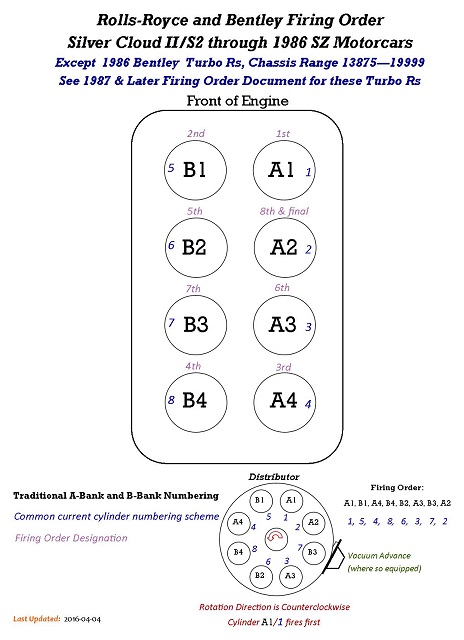 This appears to confirm the distributor being approximately (if not exactly) 180° off where it should be. I am operating under the presumption that if I lift the distributor such that the coupling is freed up, and I rotate it 180° and put it back, I should be in the position to try to start the car again (even though I am not at precisely on the TDC mark since I know that the compression stroke just created its characteristic puff). If I'm overlooking something or somehow have something off in my thinking please let me know. Once I have confirmation (or refutation) I'll do what's necessary next. At the moment I think that's doing that distributor adjustment, replacing the spark plugs, and trying to fire her up again. Brian | ||
ross kowalski Grand Master Username: cdfpw Post Number: 607 Registered: 11-2015 |
Brian, You could rotate the distributor or move the plug wires to match the current alignment of the dizzy. I prefer the latter as you can do it without any tools. The former is a better choice because it keeps the car setup standard. Either way, you should be close enough to fire and time the engine at that point. Good wrenching. | ||
Geoff Wootton Grand Master Username: dounraey Post Number: 1827 Registered: 5-2012 |
Hi Brian I'm with the "free the coupling and rotate 180 degrees" option. As far as I can see you are not overlooking anything. Go for it. With a bit of luck it will fire up and you can start tuning the engine. Geoff | ||
Patrick Lockyer. Grand Master Username: pat_lockyer Post Number: 1585 Registered: 9-2004 |
Warning, due to the length of time the vehicle engine has not been run I would strongly advise having a few fire extinguishers at the ready. Hopefully the fuel pumps will be operational after there long slumber however remember they will not work until the engine has oil pressure! Keep a close check on the carbs as the float needle and jets could become stuck due to the time factor......... | ||
Geoff Wootton Grand Master Username: dounraey Post Number: 1828 Registered: 5-2012 |
That's a good point Patrick makes. The good news for "series 1" cars is you do not have to start the engine - just turn the ignition on and allow the fuel pump to bring the system up to pressure. Any leaks will be apparent by observing the carbs etc. I recently had a leak caused by a dried out O ring on the carb filter housing, after my car had been standing for a month(ish). I'd started the engine and found the leak after it had poured petrol over the running engine. No fire, but I will always pressurize the fuel system and check for leaks in future, before starting an engine after it has been standing for a while. Geoff | ||
Brian Vogel Grand Master Username: guyslp Post Number: 2468 Registered: 6-2009 |
Geoff & Patrick, It's always a good idea to have a fire extinguisher at the ready! The series two cars are no different than the series one cars in that the engine need not be started to test out the pressurization of the fuel system. In the SY2s with the SU dual pump it's precisely as it was in the SY1s. In the SY2s with the Pierburg pump you will hear it fire up when you try to start the car. Both will pump whether there is oil pressure or not at the starting phase of the process but will cut off once the car is running if there is a sudden loss of oil pressure. Given the number of times I tried starting the car a few short weeks ago, and that the fuel pump was up and running last night with no sign of any leaks or other misbehavior on the part of the carbs (at least of the overflowing fuel type) I suspect that I am and will remain safe on that count. Last night I was in the "head half way in engine bay" position trying to get a good view of the flywheel and it took me a lot of "quick key turns" with the assistance of my partner to eventually get things settled as they are now. No fuel smell of any sort was apparent during the process. Brian | ||
Geoff Wootton Grand Master Username: dounraey Post Number: 1831 Registered: 5-2012 |
No gasoline smell at all. That would worry me, but then you have the S2 with emissions control and carbon filters. For us S1 owners, if it's not reeking  of gasoline then something's wrong. of gasoline then something's wrong. | ||
Brian Vogel Grand Master Username: guyslp Post Number: 2470 Registered: 6-2009 |
Ok, Geoff. No unusually strong fuel smell and no visible leaks anywhere were present. Every time I start SRH33576 I am immediately reminded of why emission controls came into being and that they are definitely not a bad thing (it has absolutely none). I also lived in coal and steel making country as a child and before the Clean Air Act passed in the USA. I can vividly remember the smell in the air from miles around when they opened the top of the blast furnace and how the homes and any stationary objects within about a 2 mile radius of the mill were stained with red iron oxide from said repeated openings. I prefer to be able to breathe and to breathe clean air! Brian | ||
Patrick Lockyer. Grand Master Username: pat_lockyer Post Number: 1586 Registered: 9-2004 |
Geoff, I agree I would be most worried as to having no smell of petrol. As has been stated quote "Given the number of times I tried starting the car a few short weeks ago" [And two + years ago] This would result in unburnt fuel smell exiting from the exhaust if all was ok. Maybe after 2+ years of being laid up some parts of the fuel system have faults. Another failing with time with unburnt fuel left in the exhaust could maybe block up and damage the cats if fitted! | ||
Christian S. Hansen Grand Master Username: enquiring_mind Post Number: 624 Registered: 4-2015 |
I do not mean to gloat, but also wonder if RR knew that they were creating such a problem queen when they designed the Shadow, and this is why I love the pre-war and early post war cars. They are so simple and forgiving. Recent events have necessitated my moving a '36 RR 25/30 and '35 Derby Bentley, both of which have been in storage for over 15 years and with little more than the garage doors opened every year or two to verify that they have not been stolen. Both ran fine when parked. After pulling spark plugs, injecting a few ounces light oil into cylinders as well as rocker area, turning engine over by hand a few revolutions, adding a gallon of fresh gasoline to the 15 year old already in tank, ignition on, wait for SU fuel pumps to stop clicking...and both fired right up without drama. The Bentley purrs like a kitten. Changed engine oil and off we drove. Like I said...very forgiving, no drama, and built in a era of planned longevity. Mostly issues are a matter of disassembly, adjustment, lubrication, reinstallation, and off you go. Seems like the Shadows are a case of unintended consequences if they develop issues when parked for only weeks or months. So far I have been fortunate with my '67 MPW! Fingers crossed, next time I try to start it! . |